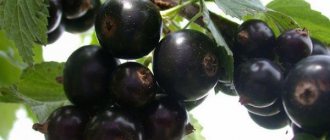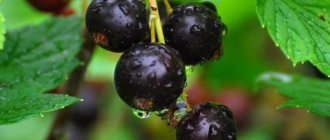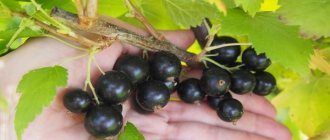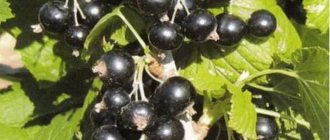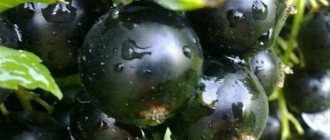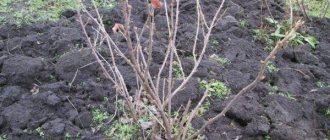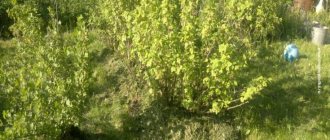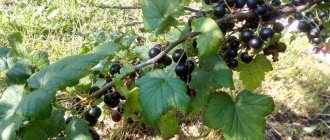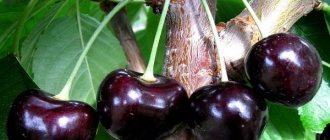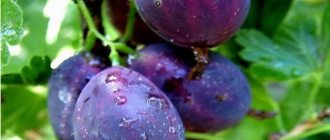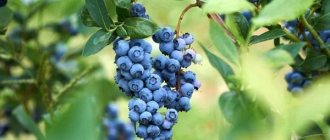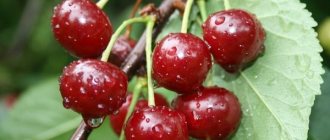Black currant Izyumnaya was bred in the Bryansk region on the basis of the All-Russian Research Institute of Lupin, obtained after pollination of the Golubka seedling with pollen of form 37-5. A.I. Astakhov worked on the variety.
Izyumnaya is a relatively young variety: its testing began in 1995, and was included in the State Register of Breeding Achievements in 2007. Designed for the Central region of Russia (Tula, Smolensk, Ryazan, Moscow, Ivanovo, Bryansk, Vladimir, Kaluga regions), but it also takes root in other areas, including Siberia, if it is covered in winter and watered in summer.
Description of the black currant variety Izyumnaya
Izyumnaya currants were bred by specialists from the All-Russian Scientific Research Institute Lupin (Bryansk region) by crossing the hybrid form 37-5 with the early ripening variety Seyanets golubki. The main goal of breeding was to obtain a crop with good immunity to powdery mildew. The author is A.I. Astakhov. The variety he bred has been listed in the State Register since 2007 and is approved for use in the Central region. In practice, it is grown throughout the country.
Currant Raisin forms upright and fairly compact bushes. Their height is average, does not exceed 1.5 m. The crown is not spreading. Young shoots are geniculate. They are green in color and have a matte surface. There is pubescence. The shoots are thick and flexible.
The roots of the Izyumnaya currant have a fibrous structure. They go to a depth of 0.35 m.
The flowering of Izyumnaya currant begins in the first ten days of May. Quite long brushes form on the bushes. Each has 7-11 large, pale yellow flowers with five petals.
Currant Raisin has three-lobed leaves with medium-sized notches and small but deep notches at the bases. Their surface is leathery and wrinkled, their shape is convex, and their color is dark green. The edges of the leaf blades have blunt teeth. The middle blades are long, their tips are medium-pointed.
Currant Raisin produces large, round fruits. Their color is matte black, their weight can reach 3.3 g. Such indicators are ensured by proper comprehensive care.
The berries of this variety have a sweet taste. Almost 10% are sugars, while acids are contained 5-6 times less. There are about 200 mg of vitamin C per 100 g of pulp. Raisin currants are classified as dessert varieties. Its tasting score is 4.3 points.
The fruits of Izyumnaya currants ripen already at the beginning of July, their ripening is smooth
Advantages and disadvantages of the variety
One of the main advantages of the variety is the long-term storage of berries on the bush. They do not crumble, but dry, turning into raisins. Berries contain 10 times more sugar than acid. The brushes are large and easy to collect. The advantages of the variety also include its winter hardiness, drought resistance, resistance to diseases and pests: bud mites, powdery mildew and fungi.
Breeders consider poor rooting by woody cuttings to be a disadvantage of this variety. Selection work in this direction continues.
To get a good harvest of this currant variety, you need to:
- Have on your land plot currant bushes that satisfy your needs: high-yielding with large berries;
- Plant young plants in fertilized soil in the autumn;
- Carry out fertilizing and mulching;
- Regular watering and sprinkling;
- Inspection of bushes and control of aphids;
- Mandatory thinning of bushes.
As a result, Izyuminka currants will please gardeners, summer residents and home gardeners with a good harvest.
Characteristics
The optimal temperature for growth and fruiting of Izyumnaya currant is 20-25 °C. This variety tolerates heat well.
Drought resistance, frost resistance
Currant Raisin exhibits relative resistance to drought. This variety is not afraid of sudden temperature changes. In terms of frost resistance, it belongs to zone 4a, since it can withstand cold temperatures down to -34.4 °C.
Productivity
Izyumnaya currants begin to bear fruit in the first half of July. On average, you can collect 1.7 kg of berries from a bush, the maximum yield reaches 3.5-4 kg. The first five years after planting the indicators are low. Fruiting begins in the second year and lasts until about 15 years.
Raisin currants are not prone to shedding due to the special structure of the cuttings. The berries can remain on the bush almost until autumn. Gradually, under the sun, they wither, turning into a kind of raisins. This feature gave the variety its name.
As the branches age, the berries become noticeably smaller. Productivity may decrease due to ovary falling off during heat or drought.
Important! Acidic soil is not suitable for Raisin currants. This is fraught with inhibition of growth, crushing of berries, and reduced yield.
Application area
The fruits of the Raisin currant are universal. They are good fresh, suitable for freezing and canning - making preserves, jams, compotes, juice. The leaves of this variety are also used, adding them for taste and aroma to tea, pickling, and using them in folk medicine.
If you pick Raisin currants in dry weather, the berries tolerate transportation well. For it you need to choose small containers that must be ventilated. The fruits store well if collected before they wither.
Advantages and disadvantages
Raisin currants contain a lot of sugar compared to other varieties. This gives it a sweet dessert taste.
The clusters of Izyumnaya currants are large, making the berries easy to pick
pros
- resistance to frost, drought, temperature changes;
- large fruits;
- the berries do not fall off, losses are minimal;
- earlier maturation;
- ease of care;
- good immunity to powdery mildew;
- resistance to kidney mite.
Minuses
- poor rooting by lignified cuttings;
- susceptibility to septoria.
Reviews from gardeners about culture
Kriulev Yu.P., test gardener from Nizhny Novgorod
Gardeners would like to pay special attention to the Izyumnaya currant variety. The variety has excellent taste (4.7-4.8 points), is resistant to diseases, and has good winter hardiness. It does not fall off when fully ripe, but gradually dries out on the bush, as if “raisinizing,” which is where it got its name.
Sergey Chudopalov, gardener-varietal tester:
The Izyumnaya variety is even better. It's much sweeter. This variety is early, but the berries adhere so firmly to the branches that they can hang withered until winter if birds do not peck them. Their high sugar content (10-12%) makes them resemble raisins, hence the name. In addition, Izyumnaya is winter-hardy, resistant to powdery mildew and bud mite.
Black currant is traditionally considered one of the most popular and valuable berry crops. It can be found in almost every garden. There are plenty of reasons to appreciate this fragrant berry. It is relatively easy to care for, very healthy and tasty. Blackcurrant fruits are champions in vitamin C content. They contain antioxidants and biologically active substances that will contribute to the human body in its fight against environmental challenges.
One of the varieties that deserves special attention is the early, universal-purpose Izyumnaya. This variety is relatively new, it was bred at the All-Russian Lupine Research Institute at the end of the last century. Parents - form 37-5 and Dove Seedling. It has a dessert taste.
Landing
You can plant Raisin currants in the spring before the buds open or in October. The second option is preferable, since the bushes have time to take root before frost, and next year full growth and development begins.
Currant Raisin prefers sunny areas. They should be well ventilated, but not too ventilated. The soil needs to be loose and moisture-permeable, preferably loam and sandy loam enriched with organic matter. The reaction should be neutral or close to it.
Comment! For Izyumnaya currants, you need to choose an area where there is no standing water after the snow melts. The close occurrence of groundwater is detrimental to bushes.
Seedlings must be selected carefully. A healthy and well-developed root system without mechanical damage or signs of rot is important. The shoots should be flexible and succulent, the foliage without spots.
Before planting, the selected area must be dug up and added per 1 m²:
- rotted compost or humus 7-10 kg;
- superphosphate 0.1 kg;
- wood ash 1 liter or potassium salt 80 g.
It is recommended to carry out preparation 4-6 months before planting. The further algorithm is as follows:
- Make a hole with a side of 0.4-0.5 m.
- Fill the hole 2/3 with soil mixture. If no preparation has been made, then add a bucket of compost or humus, 0.2 kg of superphosphate, 0.4 kg of wood ash.
- Pour in 0.5 buckets of water.
- Place the seedling at an angle of 45°, deepen the root collar by 7-10 cm.
- Straighten the roots and cover with soil mixture.
- Compact the soil and water (0.5 buckets of water).
- Mulch the planting with dry soil or any organic matter.
When planting in spring, the branches need to be trimmed, leaving 3-4 buds. This stimulates the growth of new shoots. When planting in autumn, hilling is necessary. In early spring, excess soil will need to be removed and the bush trimmed.
Comment! Raisin currant bushes are compact, so they can be planted at intervals of 1 m. The lifespan of plants is reduced when planted closely.
It is better not to plant Raisin currants between trees, this can reduce the yield
Growing
It is much easier to grow yoshta in the garden than gooseberries or black currants. Even beginners can do this. It is enough to apply a minimum of effort, and the site is ready.
Landing
For the bush you should choose open, well-lit areas. It is worth noting that even light partial shade can make the fruit smaller and more sour, and the yield will also decrease. For decoration purposes, the bush can be planted anywhere in the garden.
The soil
The soil should be loose, light, fertile. It is preferable to use potassium fertilizers
Equally important is the presence of moisture. Excess water will lead to rotting of the root system
It is necessary that the soil is moist, but not wet. It will not be superfluous to organize drainage.
The hybrid is self-fertile. But some gardeners believe that it is better to choose black currants and gooseberries as neighbors for cross-pollination, which will further increase the harvest. However, there is no scientific confirmation of this opinion.
Landing dates
It is recommended to plant seedlings in the autumn or spring season, but this is not important. Plants with a closed root system are intended to be planted throughout the warm season.
It is recommended to plant currant seedlings in early September.
In such a way, the time reserve before the onset of cold weather remains at least 2-3 weeks. Then the young plant will have time to adapt and grow stronger. Under such conditions, in the spring the seedling will send out young shoots, and by mid-summer it will produce the first, small harvest of berries.
Distance between bushes
When using yoshta as a hedge, the distance is left 50-60 cm.
The plant is characterized not only by a powerful bush, but also by strong branches. Therefore, the planting hole should be made wide and deep, thereby creating conditions for the development and growth of the root system.
Aftercare
Currant Raisin requires comprehensive care:
- Evening watering. It is better to use a sprayer with a fine nozzle, irrigating the plantings for 1-2 hours. In dry weather, moisten the bushes at least twice a week. In spring and autumn, carry out one abundant watering - 40-50 liters per plant.
- Regular weeding.
- Mulching to retain moisture.
- Feeding. In spring, 40 g of urea per bush. After flowering and during fruiting, per plant a bucket of water with 20 g of superphosphate and 10 g of nitrogen and potassium fertilizers. After harvesting, 20 g of potassium sulfate or a glass of ash and 50 g of superphosphate.
- Trimming. Up to five years, form a crown of 15-20 strong shoots. From the 7th year of life, for rejuvenation, remove old branches, leaving 4-5 one-year-old specimens. Sanitary pruning is carried out in summer or autumn.
Comment! From the end of summer, nitrogen cannot be used for currants. It stimulates the growth of new shoots that do not have time to ripen before the cold weather.
Shelter for Izyumnaya currants is required only in regions with harsh winters, when weakened after an illness, and also in the first two years of life. Short shoots of young bushes can be covered with cloth and covered with earth. The branches of old plants should be pinned with pegs, and non-woven material should be spread on top.
Pests and diseases
Currant Raisin is especially susceptible to septoria, also called white spot. The disease most often occurs in the first half of June and manifests itself as small brown spots on the leaves, which gradually turn white in the center. The greenery dries out en masse and falls off prematurely. Possible fruit cracking.
Parts of the plant affected by septoria must be removed and burned. Treat plantings with a copper-containing preparation. For prevention, you need to remove weeds and fallen leaves, dig up the soil to 8-10 cm in the fall, and do sanitary pruning annually.
The appearance of septoria is favored by high humidity and little snowy winters.
